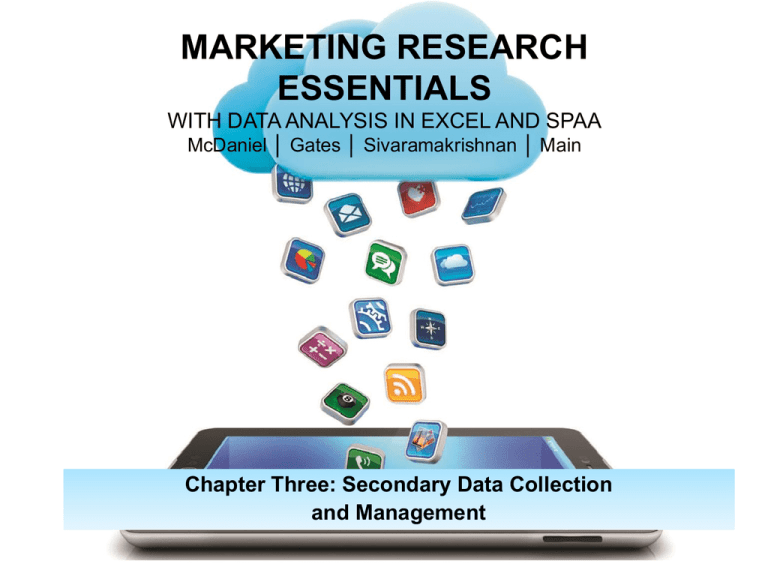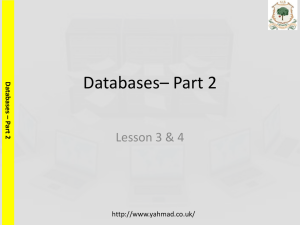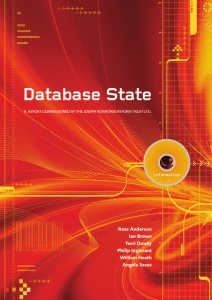
MARKETING RESEARCH
ESSENTIALS
WITH DATA ANALYSIS IN EXCEL AND SPAA
McDaniel │ Gates │ Sivaramakrishnan │ Main
Chapter Three: Secondary Data Collection
and Management
LEARNING OBJECTIVES
Chapter Three: Secondary Data Collection and Management
• Understand what secondary data is, as well as its
advantages and disadvantages
• Describe how firms create an internal database
• Explain the process of data mining
• Understand behavioural targeting
• Describe the implications of marketing research on
privacy concerns
• Describe the types of information management systems
Secondary Data
• Research results that are already published
• May be found internally (within a company) or externally
(outside the company)
• Should seek both if possible
• Collect secondary data first—before primary data (new
data gathered to help solve the problem under
investigation)
Advantages of Secondary Data
• Saves time, money, and inconvenience
• Can help to clarify or refine the issue or problem
• Might provide solution to research problem
• Might provide primary data research alternatives
• Can alert the researcher to research problems
• Provides background information, enhancing research
credibility
• May provide the sample frame
Limitations of Secondary Data
•
•
•
•
Lack of availability
Not relevant
Insufficient
Inaccurate information: always ask yourself:
1.
2.
3.
4.
5.
Who collected the data?
What was the original study’s purpose?
What was collected and how?
When was it collected?
Is it consistent with other data?
Internal Databases
• A collection of related information developed from data
within the organization
• Can be created from sales information
• Is used as a marketing tool
Internal Databases
•
Database Marketing
• Marketing that relies on the creation of a large
computerized file of customers’ and potential customers’
profiles and purchase patterns to create a targeted
marketing mix
• Allows for individualized direct marketing and
customer relationship management
Internal Databases
Neural network – a computer program that mimics the
processes of the human brain and is capable of learning
from examples to find patterns in data
Data mining
• The use of statistical and other advanced software to
discover non-obvious patterns hidden in a database
• Used in marketing for:
•
•
•
•
Customer acquisition
Customer retention
Customer abandonment
Market basket analysis
Internal Databases
Behavioural targeting
• the use of online and offline data to understand a
consumer’s habits, demographics, and social
networks in order to increase the effectiveness of
online advertising
Internal Databases
Battle over privacy:
• Identity theft
• Government actions – laws to protect personal
information and privacy
• Payment for revealing private information
Internal Databases
Marketing research aggregators:
• A company that acquires, catalogues, reformats,
segments, and resells reports already published by
large and small marketing research firms
• A growing area
• Examples: AllNetResearch.com, Profound.com,
USADATA.com
Information Management
Geographic Information Systems (GIS):
• Computer-based system
• Uses secondary and/or primary data to generate maps
• Visually displays various types of data geographically
Decision Support Systems (DSS):
• Interactive, personalized information management
system
• Designed to be initiated and controlled by individual
decision-makers
• View company information as you wish to see it
• Can also ask what if questions
Copyright
Copyright © 2014 John Wiley & Sons Canada, Ltd. All rights
reserved. Reproduction or translation of this work beyond
that permitted by Access Copyright (the Canadian copyright
licensing agency) is unlawful. Requests for further
information should be addressed to the Permissions
Department, John Wiley & Sons Canada, Ltd. The purchaser
may make back-up copies for his or her own use only and
not for distribution or resale. The author and the publisher
assume no responsibility for errors, omissions, or damages
caused by the use of these files or programs or from the use
of the information contained herein.












